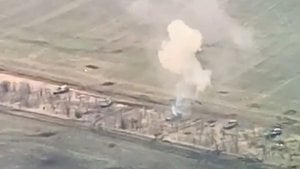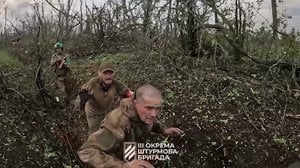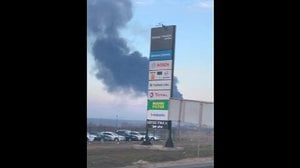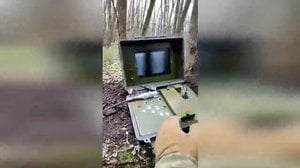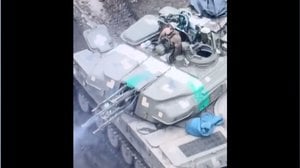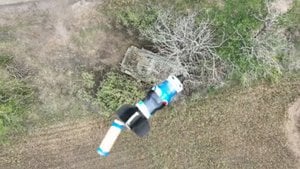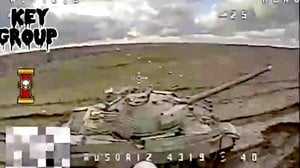
35th Brigade Assault with MRAPs and Tanks
Published 9 months ago
A combined arms assault by the 35th Brigade of the UAF against a Russian trench in Makarivka, Donetsk, using tanks, artillery, and MRAPs. The trench runs from the bottom to the top of the screen on the forward (right) edge of a tree line. Immediately behind the trench (to the left) a road a road runs parallel, and forward of the trench is a field pockmarked with craters from artillery and mines. The Ukrainian force, which looks to be a reinforced platoon or part of a company, is travelling in two columns of MRAPs and tanks, respectively, parallel to the trench. The tanks in the second column periodically fire at the trench, their rounds passing between the MRAPs. The camera shifts to a wider field of view to show what is presumably Ukrainian artillery landing just forward, on, and behind a section of trench and the bottom of the screen. A vehicle, presumably Russian, drives along the road immediately behind the trench, but its actions are unclear. The tanks continue to engage the trench, and at one point the Russians return fire with what is likely an RPG, but possibly and ATGM.
As previously mentioned, the engagement occurred near Makarivka, Donetsk, just west of Vuhledar on the Mariupol Axis. Passing near Makarivka is the T0518, a route that skirts the administrative boundary between Donetsk and Zaporizha Oblasts, and that provides an avenue of approach to Mariupol. Advancing along the T0518 and retaking Mariupol would split Russian forces and sever the land bridge between Russia and Crimea.
Tactically this engagement seems rather brazen on the part of the Ukrainians, but well executed. Who knows how long it took them to cross that field, or how many vehicles were lost in the process, but once across they seem to have found a path that they trust, and the MRAPs and tanks maintain their formation nicely. I do not get the sense that there is a huge amount of return fire from the trench, and the one obvious RPG (or ATGM) was way off target. I assume it was intentional to have artillery engage a section of trench to the left of the Ukrainian ground element, in order to keep Russian defender suppressed while reducing risk to attacking troops. If I were planning fires, I might have tried a linear sheaf along the road immediately behind the tee line, but sometimes its best to keep things simple, or perhaps this mission fulfilled a fire support task of which I am unaware.
I was skeptical about the utility of the MRAP in this conflict. When the MRAP was first developed and deployed, I thought it short sighted, a weapon designed for one threat (mines and IEDs), but with a high profile that left it susceptible to direct fire systems. In the 2006 conflict between Israel and Hezbollah, the latter used modern Russian ATGMs to good effect against Merkavah main battle tanks (MBT). To me this seemed a portent of what one might expect from near-peer adversaries or non-state actors with conventional capabilities, like Hezbollah or ISIS circa 2014, what I refer to as “parasitic proto-states.” It seemed to me, at the time, that sinking billions into a vehicle designed solely to protect U.S. and coalition troops in Iraq and Afghanistan from mines, but that was susceptible to direct-fire anti-armor systems, would come back to haunt us at a later date. When the decision was made to donate MRAPs to Ukraine, I felt we were unloading a lemon on a desperate buyer. That said, the Ukrainians seem to have made the most of the vehicle and its attributes, and while I personally wouldn’t want to do a drive-by of a Russian trench in an MRAP, I may have misjudged this vehicle and its usefulness.
About the Author

Cam
Cam served as an infantry officer in the Marine Corps, deploying to the Horn of Africa and participating in combat operations in Iraq. He currently works in the maritime industry and in the defense sector as an instructor of combined arms planning and operations. An avid sailor, Cam founded and directs a nonprofit that supports veterans and first responders through sailing.


